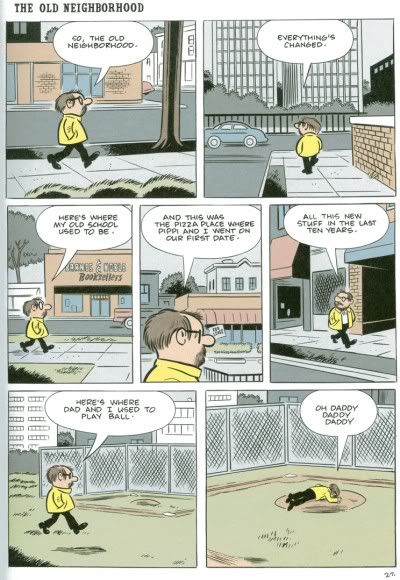
by Dan Clowes
Drawn & Quarterly, 2010
(This review originally appeared at Weird Crime Theater.)
Look, let’s get some things out of the way right off the bat. Yes, as you may have heard, Wilson is not nearly as good as many of Dan Clowes’s other works. It’s not one of his best by any means, and it seems to be aiming for a kind of Jimmy Corrigan-like poignancy which it falls far short of (I’ll get back to this), but it’s still worth talking about, which is why I’m here.
My first exposure to Clowes’s work was back in the day when I still thought comics spontaneously came into being, rather than being created by anyone: it was the Uggly Family in Cracked Magazine. Cracked of course was a poor cousin to MAD, but they did have John Severin, guys, and I was a sucker for regular features, so I soon because fixated on the Uggly Family strips. Years later, when exposed to Eightball (though Uggly actually came AFTER), the artist’s style seemed sooo familiar, though I couldn’t place where from. I figured it must have been that general retro advertising feel about the approach to the often monotone shading and angular linework. It wasn’t until someone told me flat out that Clowes did the Uggly Family that I put it together.
Whenever I think of Clowes’s art, I picture a man walking down a suburban sidewalk with his collar turned up and his shoulders hunched against the cold and wind. I can’t remember if Clowes ever actually drew a panel like this, but I can’t imagine anyone else depicting it more perfectly than Clowes could.
Clowes is kind of a big deal in my house. My wife doesn’t read a lot of comics, but she loves Clowes, and certain of his expressions (like “urban attention seekers”) have become part of our daily vocabulary. His books that I’ve read are: Like A Velvet Glove Cast In Iron, Pussey, Lout Rampage, 20th Century Eightball, David Boring, Caricature, and Ghost World. The only ones I think I’m missing are Orgy Bound and The Manly World of Lloyd Llewellyn. I’ve heard people say Lloyd Llewellyn is pretty bad, but the stories “I Hate You Deeply” and “I Love You Tenderly” are so side-splittingly genius, that I’m not sure I believe those people.
20th Century is book you will have to pry from my cold, dead hands. Lout Rampage contains mostly the same material, so you might be able to get it out of my dead hands while they are still warm. The “Ice Haven” issue of Eightball: dead hands. Caricature, and the “Ray” issue of Eightball, and Ghost World are all great (despite the recent hate-on roundtable at TCJ). Pussey is a light bit of fun. I’m still trying to make sense of David Boring and Velvet Glove. Wilson wants to be Ghost World but is landing at about Pussey level.
Quick breakdown: Middle-aged protagonist Wilson is a stereotypical Clowes misanthrope. I say stereotypical because people like to categorize Clowes characters as hateful misfits, but I don’t think any of Clowes’s other characters have been this inexorable in their one-sidedness (he does have many dimensions, but all devoted to his loathing). He literally cares more for his dog than people.
The book is 70 pages long, full color. Each page usually consists of six uniform panels. Often, each page, at first, seems to follow a kind of “gag-a-day” formula, in which Wilson meets a person, says something heartwarming to them, then in the sixth panel says something hateful (“I love people. / For the love of Christ, don’t you ever shut up?” “Hey brother – mind if I sit here? / Hey, shithead – I’m talking to you!” “How’s it going, old-timer? / It’s completely filled with dog shit.” Each page is done in one of a range of different art styles from fairly realistic (Clowes’s “traditional” style) to Casper The Friendly Ghost-like cartoonyness.
After a few pages of this, my heart began to sink. “Oh, lord, not 70 pages of this…” I thought. But then something remarkable happened — several more pages in, the seemingly unrelated gag-a-days began to coagulate into a cohesive narrative thread. But of course it did. Clowes has pulled this stunt on us many times before: Ice Haven, The Ray, and Ghost World all follow similar narrative patterns. Ice Haven in particular also has the multiple cartooning styles.
Wilson discovers his father is dying and goes to be by his side. After his father’s death, and re-examining his life in that particularly ironic Clowesian way, he decides to re-connect with his ex-girlfriend from decades earlier and discovers he has a teenage daughter with whom he also tries to bond, with disastrous results since really he is incapable of changing his ways despite verbally declaring that he can / will.
As I mentioned before, I don’t think the book is as poignant as Clowes hoped it would be. Something about this social misfit traveling back to his home town to reconcile with his father reminded me a lot of Chris Ware’s Jimmy Corrigan, and Wilson is not flattered by the comparison. It is rarely as funny as Clowes’s other stuff, and it’s not as deep either. There is one cleverly placed sequence with an icicle though — you’ll know the one when you see it — that makes no sense initially, but then comes around to be quite moving at the end. Maybe the problem is that Wilson seemingly is mostly the same at the end of the book as he was at the beginning despite having been through a whirlwind of events, any one of which would probably be life-changing for you, my three readers, and me.
For me, it is the formalist effects of Wilson that are most impressive.
1) The numerous styles used most often feel completely disconnected (or irrelevant) to the content. The result is often I found myself “ignoring” the art and spending that energy considering the characters’ inner lives. This is absolutely necessary because despite the forming narrative, Clowes still focuses on the individual pages as discrete units. It’s still a throw-away gag-a-day formula, and the varying styles forced me look deeper, ironically, by “ignoring” the art. Garfield could learn a lesson from this.
2) On one page in particular, the art and content seemed to deliberately juxtapose. Wilson’s father dies, and Wilson walks through the city contemplating before collapsing in a baseball diamond, devastated and crying, “Oh Daddy Daddy Daddy!” This was the most genuinely emotional moment for Wilson in the whole book — in public no less — but the page is drawn in one of the most cartoony of Clowes’s chosen styles (see scan). This page took me aback. Was Clowes ridiculing his protagonist with the art? Or is the fact that the art is so cartoony make the physical depiction of the character more evoking of sympathy, hence my own strong emotional reaction to the page?

3) The gag-a-day format allows Clowes to skip huge swathes of time — sometimes months between pages — and leaves the reader to figure out what events transpired to get us to the circumstances on the new page. It forces you to stop and think about things: again important because the book is only 70 pages long. It gives the book a certain depth which defies its page count…
… The only problem is I think Clowes has us thinking about things and slowing down to look at things that don’t add up to enough. Wilson is so unlike anyone I’ve ever known — much like, say, Batman — that I find it hard to see the point.
But I have to admit that maybe I’m being unfair to the book, and maybe I’m even misjudging its intentions. As a satire of the Wilson-type personality it is effective (if only rarely laugh-out-loud funny) — maybe that IS the point. And it does end on a strangely positive (?) note, which makes me wonder if the whole point was that some thing — however small — had been accomplished in Wilson’s life after all the sound and fury. Maybe the book should have been even shorter. Maybe for now I’ll shelve it next to David Boring and Velvet Glove. Maybe in ten years I’ll really get it. And maybe in 50 you’ll be prying it out of my cold, dead hands.
KS
————————————————————————————-
Kumar Sivasubramanian is the writer of Weird Crime Theater.
